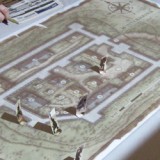Kentwood Players: The Crucible
In today’s political climate of finger-pointing and “us vs. them” mentality, Kentwood Players’ decision to put on Arthur Miller’s famous look at the Salem witch trials, The Crucible, is a timely one. The crux of The Crucible is how to find the truth when lies and accusations run rampant, a problem that resonates strongly today, as it did in 1692 (when the play is set) and in 1953 (as an allegory for McCarthyism when it was written).
The Cast
Appearing throughout the majority of The Crucible and acting as the audience’s proxy is Harold Dershimer’s John Proctor. While the world around him spirals into chaos, and most of his friends and even his wife are sentenced to prison and accused of witchcraft, Proctor maintains his rationality and serves as a clear voice among the madness. Dershimer, while clearly very talented and comfortable on stage, almost felt too contemporary for the piece. With every eye-roll and shrug, he seemed to be telegraphing to the audience that the chaos on stage was idiotic. It wasn’t that he was bad at all, I just didn’t think his take on the character meshed well with the rest of the cast, especially given the time period.
The Crucible, in my opinion, really excelled in four extremely grounded female performances – Belinda A. Skinners Tituba, Sydney Holliday’s Mary Warren, Caitlin Barry’s Abigail Williams, and Jennifer Sperry’s Elizabeth Proctor. These four women provided the sturdy frame for the rest of the play to rest upon. Skinners brought a quiet strength (and great accent) to Tituba, a Barbados slave forced to admit to false claims of witchcraft in order to survive. Holliday rode an emotional roller-coaster as Mary Warren, at first on board with Abigail’s lies, then finding courage to call out the absurdity before finally submitting to Abigail’s malicious intentions. Abigail Williams, potentially a very one-dimensional character, was brought to life by Caitlin Barry. At any given moment, I could see the gears turning in her head, trying to figure out how best to profit from the religious fervor in Salem. Sperry’s Elizabeth Proctor, a woman scorned but still fighting for her marriage, shone the brightest. Seeing Sperry think through the gravity of her situation was heartbreaking. Often taking a backseat to the more dramatic characters of Abigail and John, Elizabeth quietly brought weight to the horrors of mass hysteria.
Filling the stage with humor and heart, I adored Dan Adams as Giles Corey, a man who questions his wife’s choice in literature only to lose her to the out-of-control court rulings. As opposing Reverends, Brad Halvorsen (John Hale) and Daniel Kruger (Samuel Parris) were both strong actors, one searching for truth, the other for a way to save his standing in the community. Stuart James Galbraith demanded attention as Deputy-Governor Danforth, a man refusing to back down from the trials, despite the overwhelming destruction of the community.
As a non-profit community theater organization, Kentwood Players casts actors of all backgrounds – from young performers setting their first steps on the stage to seasoned veterans with dozens of shows on their resumes. While it was sometimes obvious when actors were more uncomfortable than others, it is commendable that Kentwood Players takes chances and gives opportunities that more higher-end theater companies might not.
This and That
With The Crucible taking place in 1692, the sets and props were really a stand-out for me. Transforming the stage into 2 different houses, a courtroom, and a dungeon, Doug Carlson’s sets and Sheldon Cohen’s props were outstanding. Especially in the Proctor house, where the little details in the walls and props gave the impression of a living, breathing kitchen, complete with wash basin and a “lit” stove. Because the sets and props were so intricate, the scene changes dragged. There were often too many people on stage standing around, or too few actually helping move things along. In a cast of around 25, many young actors, the scene changes could be quicker and more efficient.
Although the sets were quite stellar, there were occasionally too many actors on stage, creating a sense of chaos within the space. In the last scene in particular, there seemed to be too little room for all the characters needed. The important moments and emotional core got lost in the crowd. In order to refocus the audience’s attention to where it should be, actors occasionally resorted to over-acting.
The costumes, albeit with a few loose buttons or ill-fitting corsets (which were probably the product of quick costume changes), were mostly a pleasure to look at, especially the men’s coats and Elizabeth Proctor’s outfit. The music and sound design were decent, although inconsistent, and the last snap of the rope went on a bit too long, leaving the actors on stage in an overwrought freeze-frame until the lights dimmed.
I could have done without the opening dance prologue. I don’t remember it being in the actual script, but I would rather have gone right into the action and dialogue than be shown the dancing in the woods. It spelled out what could have been a nice mystery. Did the girls dance in the woods? Were they conjuring spirits? Was someone naked? Or were the adults simply overreacting to the silliness of Abigail and her teenage friends?
Overall
While the cast ranged from beginners to theater vets, there were many great performances in The Crucible. I wish the accents were done away with, as some fluctuated, but overall there was a nice sense of character development and intention. The sets provided a gorgeous backdrop to the tragic tale of a world gone mad. Taking a cue from The Crucible, maybe present-day extremists could learn that “right” isn’t about who shouts the loudest or points the most fingers. We could learn from Reverend Hale and, with an open mind, try to get to the heart of the truth, perhaps changing our point of view in the process.
The Crucible runs weekends through February 17.


















